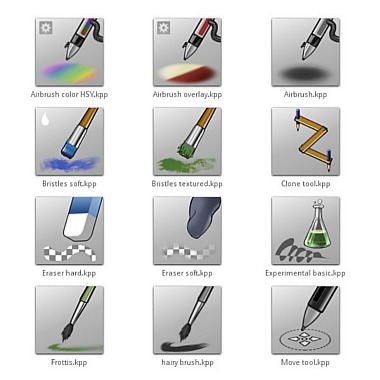

(Don’t forget you can use the eraser mode for subtle erasing with the line tool as well) Then use the airbrush_pressure with the line tool to make some light-shafts of different sizes on a separate layer.
KRITA BRUSHES SOECIAL EFFECTS HOW TO
Then take the gradient tool, and set the blending mode to color and the paint tool to a light blue, so we can get in the bluish atmospheric effect. Question Could you do a tutorial on how to recreate the look of light refracting in water Sure, caustics, it’s not like it’s the most complicated effect known to CG graphics Okay, so the first thing is that light effects never work in isolation: you need to be spot on with colors and other effects to make it work. This is only per stroke, so make a lot of long ongoing strokes with this brush to make use of it. ( I failed at this) The great thing about the sketch brush is that it causes those little ‘melt-togethers’ where two lines cross. Make sure to try and follow the shapes you made. The color dodge blending doesn’t work well on a separate layer, so do it on one that also has the ground on it.) Then you start slowly building up your lines. (It only works per single perspective assistant, making it not very good for chaining, but for our purpose this is good.) This will cause the brush to give smaller lines the further it registers on the perspective assistant. It doesn’t need to be perfectly in perspective, because we’ll only use it for the perspective sensor. Then, use the assistant editor tool to add a perspective grid. Outside of pressure for making varying strokes, glowiness for the light and extra density, we also want to have the size of the line decrease the further away it is… Color dodge will cause a move towards white by applying special dodge color maths to our brush dabs instead of the Normal averaging color maths. Set the brush blending mode to Color Dodge, and select the color of our caustics. Take sketch_ink_big, and add pressure to the Line width while setting Density under the Brush size to 100%.

Caustics are a bit hairy, which means it’s a good candidate for the sketch brush engine. This pack also comes with an accompanying pattern pack. Cityscape Brushes: If landscapes aren’t your thing and you’d rather paint futuristic or fantasy cities, Iforce has a pack for you as well. Bark Shapes: Give those trees a friend with this Bark Shapes pack. (If you reverse the pressure curve on the scatter, this’ll be easily done by increasing the pressure on the stylus) In a nutshell, the / curve has a smooth transition, the S curve spends more time being really big and really small, and you can remove either of the middle control points in the S curve to make a brush that gets small easily but not large, or vice versa. Cloudpack: Happy little clouds abound with this pack dedicated to cloud brushes. Note how the smudge brush here is used not just to mix areas, but also to create definition of borders by lowering the scatter. We create a simple smudge brush by taking smudge_soft and adding scattering to it, as well as an s-curve on the smudge length. The eraser mode works with gradients as well, so use that to your advantage! We set up something simple with gradients. So we first need to recreate the surroundings a bit. Sure, caustics, it’s not like it’s the most complicated effect known to CG graphics… Okay, so the first thing is that light effects never work in isolation: you need to be spot on with colors and other effects to make it work. I highly recommend starting out with ~80 opacity and ~80 flow when painting, testing out different values as you go to see how they work.Could you do a tutorial on how to recreate the look of light refracting in water? However, there are three settings that I highly recommend you learn to use right from the beginning: brush size, opacity, and flow! These settings are SO powerful and important, and they really contribute to both the look and feel of digital painting in Krita and other programs alike. Just like with traditional painting, it's best to start learning from the simplest brush first (basic round or flat, for example) and gradual work your way to more complex and specialized brushes later! There are tons of cool brushes out there, for sure, but I find it's a much better idea to start out with a handful of very simple brushes and focus on the fundamentals of painting (line, shape, form, contrast, lighting, color, composition, etc.).

Personally I think one of the biggest pitfalls of digital painting is getting too caught up in fancy brushes and effects at the beginning of your journey. Honestly, Krita's new built-in brushes are a great place to start! You can filter by the "sketch" and "paint" tags for and start from there.


 0 kommentar(er)
0 kommentar(er)
